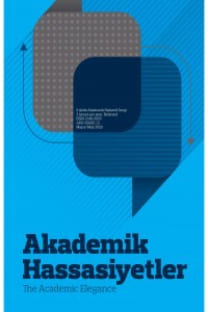SOSYAL BİLİMLERDE BİR ARAŞTIRMA ALANI OLARAK SİVİL-ASKER İLİŞKİLERİ
Bu makalede 1950’li yıllardan itibaren siyaset bilimi ve sosyoloji disiplinlerinin parçası olarak ortaya çıkıp, zaman içinde bu iki disiplin dışındaki farklı sosyal bilim dalları ile de ilişkisi nedeniyle çok-disiplinli bir karakter kazanan sivil-asker ilişkileri çalışmalarının evrimi ele alınmaktadır. Bu bağlamda, alanın hangi saiklerle bir araştırma konusu olarak geliştiğinin ortaya konması ve alandaki çalışmalara yön veren kuram ve modellerin bir çerçeveye oturtularak değerlendirilmesi amaçlanmaktadır. Çalışmanın, böylelikle, sivil-asker ilişkileri araştırmalarını şekillendiren ortak kavram ve parametreleri tanımlaması hedeflenmektedir. Çalışma, sivil-asker ilişkileri alanındaki kuramsal çabaları iki ayrı evrede incelemektedir: Geç-Modern Evre (1950-1980) ve Post-Modern Evre (1990 ve sonrası). Bu iki evrenin, alan açısından ne şekilde farklılaştıkları, kuram ve modellerde görülen yaklaşım ve öncelik farklılıkları üzerinden açıklanmakta, ayrıca sözkonusu evrelerde üretilen ve dönemdeki diğer akademik çabalara öncülük eden önemli çalışmalar hakkında genel bir bilgi verilmektedir. Bu şekilde de demokrasi tarihi boyunca sorunlu bir seyir izlemiş durumdaki Türk sivil-asker ilişkileri üzerinde çalışan akademisyenlerin kuramsal çabaları açısından da kılavuzluk anlamında bir katkı sağlayabileceği öngörülmektedir.
Anahtar Kelimeler:
sivil-asker ilişkileri sorunsalı, kültürel uçurum, profesyonellik, pretoryanizm
CIVIL-MILITARY RELATIONS AS A FIELD OF ACADEMIC INQUIRY WITHIN SOCIAL SCIENCES
This article concerns the evolution of the studies of civil-military relations that emerged in the 1950s as part of the disciplines of sociology and political science, and that began to reflect a multi-disciplinary character in time as it demonstrated interaction with other branches of social sciences in addition to these two branches. It focuses on the issues that motivated its development as an academic field of inquiry, and on the assessment of theories and models that shape research in the field by evaluating them within a conceptual context. The study aims to define common concepts and parameters that underline research into the civil-military relations. The paper examines the theoretical efforts in the field in two different phases: Late-Modern Phase (1950-1980) and Post-Modern Phase (1990 and onwards). It explains how these phases differ through the differences in theoretical models in terms of their approaches and priorities. It also gives overall information about the important theoretical models of these phases that had a considerable impact on other studies of the period. In this context, it aims to make a contribution in terms of guidance to the efforts of scholars working on Turkish civil-military relations that reflected a troublesome character in Turkey’s democratic history.
___
- Akyürek, S. (2010). Zorunlu Askerlik ve Profesyonel Ordu. İstanbul: Bilgesam Yayınları.
- Cizre, Ü. (1993a). AP-Ordu İlişkileri. İstanbul: İletişim Yayınları.
- Cizre, Ü. (1997b). The Anatomy of Turkish Military’s Political Autonomy. Comparative Politics. 29. Cilt, 2. Sayı, 151-166.
- Clausewıtz, C. (1984). On War. (der. ve İngilizce’ye çev. Michael Howard ve Peter Paret). New Jersey: Princeton University Press.
- Cohen, S (1992). The Military in India and Pakistan: Contrasting Cases. South AsiaMiddle East Seminar Toplantısında Sunulan Tebliğ, Chicago: University of Chicago.
- Desch, M. (1999). Civilian Control of the Military: The Changing Security Environment. Baltimore: Johns Hopkins University Press.
- Feaver, P. D. (1996a). The Civil-Military Problematique: Huntington, Janowitz, and the Question of Civilian Control. Armed Forces and Society. 23. Cilt, 2. Sayı, 149-178.
- Feaver, P. D. (2003b). Armed Servants: Agency, Oversight, and Civil-Military Relations. Cambridge: Harvard University Press.
- Feaver, P. D., Kohn, R. H. ve Cohn, L. P. (2001). Introduction: The Gap Between Military and Civilians in the United States in perspective. (der. Peter D. Feaver ve Richard H. Kohn). Soldiers And Civilians: the Civil-Military Gap and American National Security. Cambridge: MIT Press, s. 1-12.
- Peri, Y. (2006). Generals in the Cabinet Room: How The Military Shapes Israeli Policy. Washington D.C.: US Institute of Peace Press.
- Finer, S. E. (2006). The Man on Horseback: The Role of the Military in Politics (3. B.). New Jersey: Transaction Publishers.
- Huntington, S. P. (1968a). Political Order in Changing Societies. New Haven: Yale University Press.
- Huntington, S. P. (1957b). The Soldier and The State: The Theory and Politics of CivilMilitary Relations. Cambridge: Harvard University Press.
- Janowitz, M. (1960a). The Professional Soldier: A Social and Political Portrait. New York: Free Press.
- Janowitz, M. (1964b). The Military in the Political Development of New Nations: An Essay in Comparative Analysis. Chicago: The University of Chicago Press.
- Khuri, F. (1981). Modernizing societies in the Middle East. (der. Murray Janowitz). CivilMilitary Relations: Regional Perspectives. London: Sage Publications.
- Lasswell, H. (1997). The garrison state”, (der. Jay Stanley). Essays on The Garrsion State. London: Routlegde, s. 55-74.
- McLean, I. ve McMillan, A. (der., 2009). The Concise Oxford Dictionary of Politics (3. B.). New York: Oxford University Press.
- Moskos, C. (2000). Toward A Postmodern Military: The United States As a Paradigm. (der. Charles Moskos, John Allen Williams ve David R Segal). The Postmodern Military. New York: Oxford University Press, s. 14-31.
- Nordlinger, E. A. (1977). Soldiers in Politics: Military Coups and Governments. New Jersey: Prentice Hall.
- Özdemir, H. (1989a). Rejim ve Asker. İstanbul: Afa Yayıncılık.
- Özdemir, H. (1994b). Ordunun Olağandışı Rolü. İstanbul: İz Yayıncılık.
- Schiff, R. L. (2009). The Military and Domestic Politics: A Concordance Theory of CivilMilitary Relations. London: Routledge.
- ISSN: 2148-5933
- Yayın Aralığı: Yılda 3 Sayı
- Başlangıç: 2014
- Yayıncı: A Kitap
Sayıdaki Diğer Makaleler
TÜRK MİLLİYETÇİLİĞİ VE KEMALİZM MESELESİ: HEGEMONYA, ASİMİLASYON, MÜCADELE
TÜRK ROMANINDA KENT ÜTOPYASI: PEYAMİ SAFA’NIN SİMERANYA’SI ÜZERİNE BİR İNCELEME
SOSYAL BİLİMLERDE BİR ARAŞTIRMA ALANI OLARAK SİVİL-ASKER İLİŞKİLERİ
ULUSLARARASI ÖRGÜTLERİN MEŞRULUĞU ÜZERİNE: DE FACTO OTORİTE
KOOPERATİF İŞLETMELER VE İLİŞKİSEL PAZARLAMA: BİR MODEL YAKLAŞIMI
MAX HORKHEIMER VE THEODOR W. ADORNO’DA MODERN İNSAN VE TÜKETİM İDEOLOJİSİ
Fatma Begüm ÖZEL, Alper MUMYAKMAZ
PERSONEL GÜÇLENDİRME İLE ÖRGÜTSEL BAĞLILIK ALGISI VE İLİŞKİSİ: LİMAN İŞLETMESİ ÇALIŞANLARI ÖRNEĞİ
